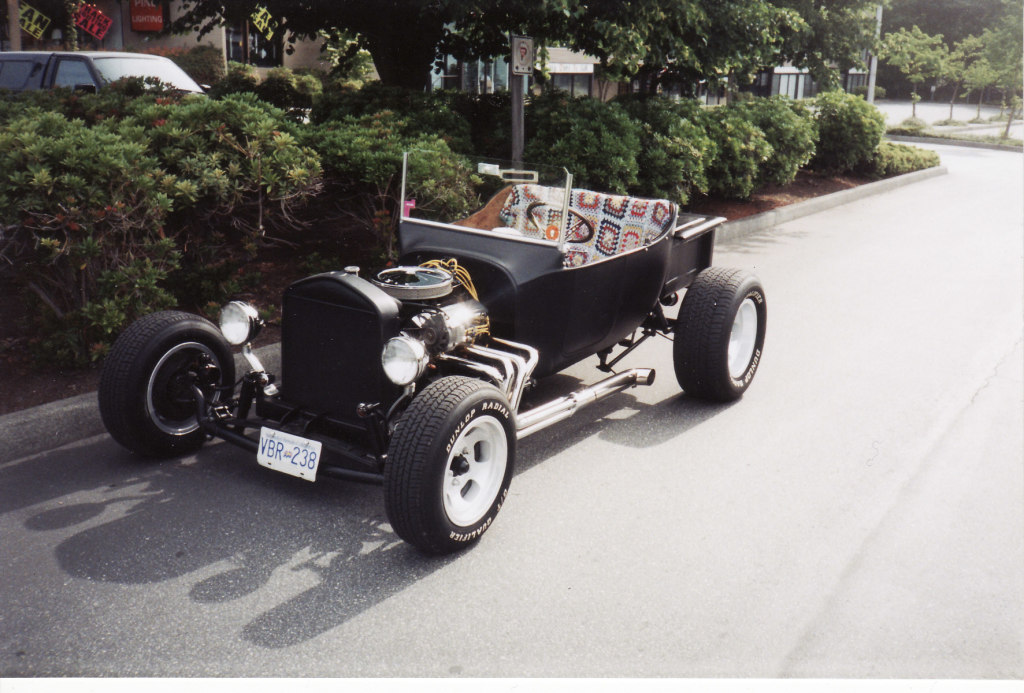In an earlier post I stated that if auto maker Henry Ford could see what Leroy Fague is doing to his cars, he’d likely want to come back and join in the fun. Leroy’s cars are practical, go fast, and charm the senses. He works alone in his garage on Old Hedley Road, relying on ingenuity and using parts he has harvested from retired vehicles.
When Leroy parked his 1936 Ford in front of my neighbour’s home recently, I couldn’t resist the urge to get up close.
“It was originally a one ton fire truck stationed at the Bellingham Airport,” he told me. “Front and rear suspension come from a Mustang. The engine is a chev 327 small block. I built the box myself. The seat is from a Dodge minivan.” His recitation included a dizzying array of parts from other vehicles. I gathered that this pretty pickup is a Ford mostly in name and appearance.
Before he drove away he said, “come over sometime and I’ll show you what I do. I’ll give you and your wife both a ride.”
Linda and I accepted the offer this week and found that entering his single car garage was somewhat akin to stepping back into an earlier era. A 1928 Chrysler coupe, partially finished, invited our attention.
“It was built without a roof originally,” Leroy explained. “They didn’t have the technology to stamp a roof then. Someone put this roof on it later, but it’s flawed.” He pointed to rippling in front and along the sides. He’ll fix that.
As he talked it became apparent that Leroy is meticulous and passionate, much like a Nobel Prize winning scientist. He’s an artist, a creative genius.
Pointing at the head lights on the Chrysler he said, “It took some fiddling to get the lights mounted at the height where they look best. I built the fenders, chassis and frame. You can see it has a rake (slant). That’s to make it look like it can go fast.”
“When I have a car at a certain stage,” he said, “I push it out and eye ball it from about 50 paces. If it doesn’t look right, I push it back in, take it apart and do it again.”
When I asked where he learned to build cars, he said, “I had zero training, just a desire to do it. When I started building my first car, a 1923 Ford Model T, I got a shop to create a windshield frame for it. They did a poor quality job but charged a lot. After that I read and studied and learned to make parts like this myself.”
He remembers that 1923 Model T as a fun car. “It weighed 1920 pounds and had 300 horse power. It was very fast.”
“That was about 40 years ago,” he said. “One day I raced a Porsche from Whistler to Vancouver. It couldn’t keep up. My wife was pretty unhappy with me. That’s something I don’t do anymore.”
The Model T drew enough police attention to make him uncomfortable. “They pulled me over for noise, for no fenders, and sometimes out of curiosity. One officer told me he didn’t like my car. He kept me waiting more than an hour in a hot sun, in a car without a roof. After that I put an ad in the paper and sold the car.”
Leroy has obviously matured a good deal in the intervening years. He is excited about his creations, but not boastful. His approach to car building is pragmatic. “I build practical cars that can be driven anywhere, anytime. I’ve driven the 1936 Ford pickup 18 years. It’s never let me down. I expect my vehicles to be mechanically sound.”
I asked my last question and then reminded him of the promised ride in the pickup. He took Linda first. When it was my turn, he found a quiet road and stepped on the accelerator. The ride remained smooth and comfortable. “We’re doing 70 mph now,” he said. “Should I do 100?”.
Appraised at $36,500, this pretty truck is well beyond my budget. Anyway, Leroy says it’s not for sale. I can understand why.
